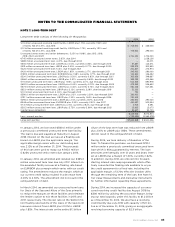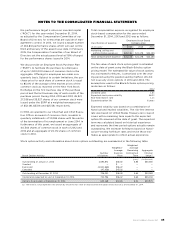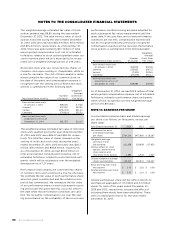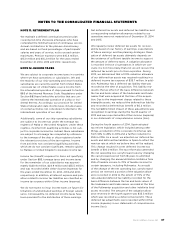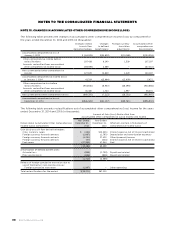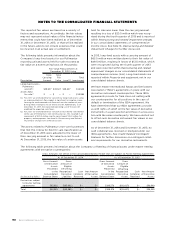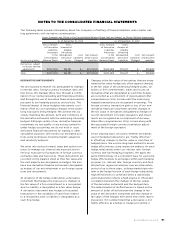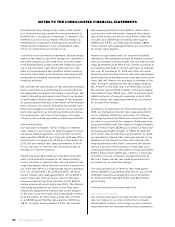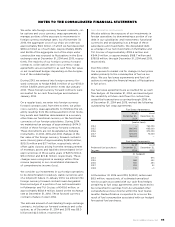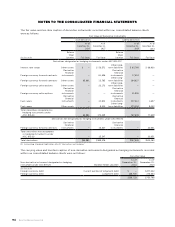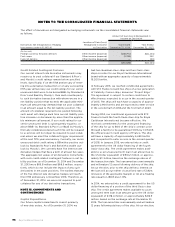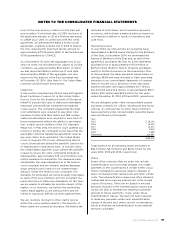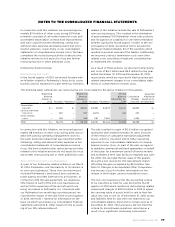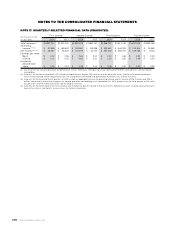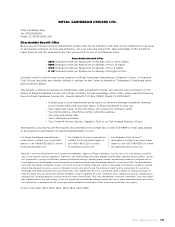Royal Caribbean Cruise Lines 2014 Annual Report Download - page 92
Download and view the complete annual report
Please find page 92 of the 2014 Royal Caribbean Cruise Lines annual report below. You can navigate through the pages in the report by either clicking on the pages listed below, or by using the keyword search tool below to find specific information within the annual report.
Royal Caribbean Cruises Ltd. 91
NOTES TO THE CONSOLIDATED FINANCIAL STATEMENTS
The following table presents information about the Company’s offsetting of financial liabilities under master net-
ting agreements with derivative counterparties:
Gross Amounts not Offset in the Consolidated Balance Sheet that are Subject to Master Netting Agreements
As of December 31, 2014 As of December 31, 2013
(In thousands of dollars)
Gross Amount
of Derivative
Liabilities
Presented
in the
Consolidated
Balance Sheet
Gross
Amount of
Eligible
Offsetting
Recognized
Derivative
Assets
Cash
Collateral
Pledged
Net Amount
of Derivative
Liabilities
Gross Amount
of Derivative
Liabilities
Presented
in the
Consolidated
Balance Sheet
Gross
Amount of
Eligible
Offsetting
Recognized
Derivative
Liabilities
Cash
Collateral
Pledged
Net Amount
of Derivative
Liabilities
Derivatives subject
to master netting
agreements () — () () — ()
Total () — () () — ()
DERIVATIVE INSTRUMENTS
We are exposed to market risk attributable to changes
in interest rates, foreign currency exchange rates and
fuel prices. We manage these risks through a combi-
nation of our normal operating and financing activities
and through the use of derivative financial instruments
pursuant to our hedging practices and policies. The
financial impact of these hedging instruments is pri-
marily offset by corresponding changes in the under-
lying exposures being hedged. We achieve this by
closely matching the amount, term and conditions of
the derivative instrument with the underlying risk being
hedged. Although certain of our derivative financial
instruments do not qualify or are not accounted for
under hedge accounting, we do not hold or issue
derivative financial instruments for trading or other
speculative purposes. We monitor our derivative posi-
tions using techniques including market valuations
and sensitivity analyses.
We enter into various forward, swap and option con-
tracts to manage our interest rate exposure and to
limit our exposure to fluctuations in foreign currency
exchange rates and fuel prices. These instruments are
recorded on the balance sheet at their fair value and
the vast majority are designated as hedges. We also
have non-derivative financial instruments designated
as hedges of our net investment in our foreign opera-
tions and investments.
At inception of the hedge relationship, a derivative
instrument that hedges the exposure to changes in
the fair value of a firm commitment or a recognized
asset or liability is designated as a fair value hedge.
A derivative instrument that hedges a forecasted
transaction or the variability of cash flows related
to a recognized asset or liability is designated as a
cash flow hedge.
Changes in the fair value of derivatives that are desig-
nated as fair value hedges are offset against changes
in the fair value of the underlying hedged assets, lia-
bilities or firm commitments. Gains and losses on
derivatives that are designated as cash flow hedges
are recorded as a component of Accumulated other
comprehensive (loss) income until the underlying
hedged transactions are recognized in earnings. The
foreign currency transaction gain or loss of our non-
derivative financial instruments and the changes in
the fair value of derivatives designated as hedges of
our net investment in foreign operations and invest-
ments are recognized as a component of Accumu-
lated other comprehensive (loss) income along with
the associated foreign currency translation adjust-
ment of the foreign operation.
On an ongoing basis, we assess whether derivatives
used in hedging transactions are “highly effective”
in offsetting changes in the fair value or cash flow of
hedged items. We use the long-haul method to assess
hedge effectiveness using regression analysis for each
hedge relationship under our interest rate, foreign
currency and fuel hedging programs. We apply the
same methodology on a consistent basis for assessing
hedge effectiveness to all hedges within each hedging
program (i.e., interest rate, foreign currency and fuel).
We perform regression analyses over an observation
period of up to three years, utilizing market data rele-
vant to the hedge horizon of each hedge relationship.
High effectiveness is achieved when a statistically
valid relationship reflects a high degree of offset and
correlation between the changes in the fair values
of the derivative instrument and the hedged item.
The determination of ineffectiveness is based on the
amount of dollar offset between the change in fair
value of the derivative instrument and the change in
fair value of the hedged item at the end of the report-
ing period. If it is determined that a derivative is not
highly effective as a hedge or hedge accounting is




